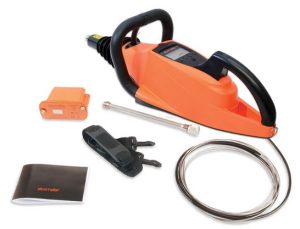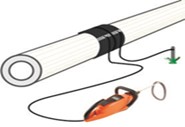Home » Products » Coating Inspection » Pinhole / Porosity Detection » Spark / Holiday Testers » Elcometer 280 Pulsed DC Portable Holiday / Spark Detector
Elcometer 280 Pulsed DC Portable Holiday / Spark Detector

Product Description
The Elcometer 280 Pulsed DC Portable Holiday is a ‘stick type’ holiday detector which has been designed to make pulsed DC high voltage holiday detection safer, easier and more reliable than ever before.
Using state of the art electronics, the Elcometer 280 allows users to inspect coatings – without connecting the earth return lead to the component substrate – ideal for inspecting large surfaces and pipelines.
• Flashing display, bright LED and a user adjustable volume alarm indicates detection of a holiday
• 0.5 – 35kV range (user selectable) for detecting porosity in coatings up to 25mm (1″) thick
• Safety trigger integrated inside the handle cuts power if released
• Rugged, shock proof and water resistant design to ensure long life – even in harsh environments
• Balanced, ergonomic design, complete with shoulder strap allows long periods of continuous use
• A wide range of interchangeable probe accessories available – compatible with all Elcometer holiday detectors – please order as a separate item.
• Ideal for testing clean, damp, dirty or slightly conductive coatings
• Voltage calculator automatically sets the correct voltage from your coating thickness value
• Internal jeep tester ensures that the selected voltage equals the test voltage
The Elcometer 280 Pulsed DC Portable Holiday uses the high voltage pulsed DC technique to detect holidays in coatings – even if the coating is damp, dirty or slightly conductive.
From the two stage safety switch, bright LED’s and screen icons signifying when the high voltage is on, to the extended ribbing to protect the user from spark creep, the Elcometer 280 sets the standard for high voltage measurement safety.
Using the wide range of probe accessories users can detect porosity / holidays in coatings up to 25mm (1″) thick.
Rugged, shockproof and water resistant, each unit is designed for use even in the harshest of environments.
Features of the Elcometer 280 Pulsed DC Holiday Detector
* The battery life is dependant on selected voltage and load applied – see Technical Specification for more information The Elcometer 280 Pulsed DC Holiday Detector can be used in accordance with: • ISO 29601 * Standards not in bold have been superseded but are still recognised in some industries |
 |
Specifications
Elcometer 280 Pulsed DC Portable Holiday / Spark Detector – Specifications
| Description | Model S | Model T | Certificate |
| Elcometer 280 Pulsed DC Holiday Detector | D280-S—- | D280-T—- | ο |
| Elcometer 280 Pulsed DC Holiday Detector Inspection Kit | D280-S-KIT | D280-T-KIT | ο |
| Rugged, Shock Proof & Water Resistant | ● | ● | |
| Integrated Safety Trigger Switch | ● | ● | |
| Quick Release Battery Pack | ● | ● | |
| Internal Jeep Tester | ● | ● | |
| Integrated Voltage Calculator | ● | ||
| Pulsed DC High Voltage Range | 0.5kV – 35kV | ||
| Voltage Adjustment | User adjustable: 0.5 – 1kV: 10 Volt steps, 1 – 35kV: 100V steps | ||
| High Voltage Output Accuracy | ±5% or ±50V below 1000 Volts | ||
| Pulse Repetition Rate | 30Hz | ||
| Operating Temperature | 0°C to 50°C | ||
| Power Supply | Rechargeable lithium ion battery, fully charged within 4 hours | ||
| Typical Battery Life | Battery life is dependent on selected voltage and load applied; 12″ (DN305) Rolling Spring 30 hours at 10kV 12 hours at 35kV 40″ (DN1016) Rolling Spring 22 hours at 10kV 8 hours at 35kV |
||
| Instrument Case Dimensions | PC ABS case; (l x w x h): 603 x 219 x 193mm | ||
| Weight (no probes attached) | 3.0kg – including battery pack | ||
| Certificate Available | Certificate of Calibration: issued for Fixed Calibration equipment and shows readings and traceability. | ||
ο Optional Calibration Certificate available
Packing List
Elcometer 280 Pulsed DC Holiday Detector Gauge (Model S or T)
- 5m trailing signal return lead
- Battery pack
- Battery charger with mains cables
- Shoulder strap
- Operating instructions
Elcometer 280 Pulsed DC Holiday Inspection Kit (Model S or T)
- 5m trailing signal return lead
- Battery pack (2 supplied with Model T)
- Battery charger with mains cables
- Stainless steel rolling spring holder (supplied with Model T only)
- 250mm probe extension shaft
- Shoulder strap and
- Operating instructions
- Wheeled transit Case
Data Sheet
Elcometer 280 Pulsed DC Portable Holiday / Spark Detector – Data Sheet
Elcometer 280 Pulsed DC Portable Holiday Spark Detector Data Sheet
Elcometer 266 & 280 DC Holiday Detector Accessories Data Sheet
Standards
Elcometer 280 Pulsed DC Portable Holiday / Spark Detector – Standards
The Elcometer 280 Pulsed DC Holiday Detector can be used in accordance with:
• ISO 29601
• AS 3894.1
• ANSI/AWWA C203
• ANSI/AWWA C214
• ASTM D4787
• ASTM D5162
• ISO 29601
• JIS G 3491*
• JIS G 3492*
• NACE RP0274
• NACE SP0188
• NACE SP0490
• NACE TM0186
• NACE TM0384
* Standards not in bold have been superseded but are still recognised in some industries
Accessories
Elcometer 280 Pulsed DC Portable Holiday / Spark Detector – Accessories
(Click HERE for separate Accessories leaflet for a comprehensive list of Accessories including Right Angle Probes, Rolling Springs)
| Part Number | Description |
| T28022769 | Light weight, rugged, wheeled transit case – ideal for gauge transportation with additional space to house up to 20m of phosphor bronze or 6m of stainless steel rolling spring |
| T28022637-1 | Grounding Mat 750mm long – for pipe diameters up to 9” (NPS)/ 229mm (DN) |
| T28022637-2 | Grounding Mat 1500mm long – for pipe diameters up to 18” (NPS)/ 457mm (DN) |
| T28022637-3 | Grounding Mat 2500mm long – for pipe diameters up to 30” (NPS)/ 762mm (DN) |
| T28022637-4 | Grounding Mat 3500mm long – for pipe diameters up to 42” (NPS)/ 1067mm (DN) |
| T28022748 | Grounding pin; 60cm long x 0.2cm diameter |
| T28022622 | Trailing signal return lead, 5m |
| T28022749 | 10m earth lead, clips each end |
|
Grounding mats are ideal for testing on un-grounded pipes. The conductive rubber mat is wrapped around the coated pipe and connected to both the grounding pin (supplied separately) and the signal return lead. |
|
| Grounding mats | ||||
| Part Number | Description | Outside Diameter (OD) | ||
| DN | NPS | |||
 |
T28022637-1 | Grounding Mat | up to 229mm | up to 9” |
| T28022637-2 | Grounding Mat | up to 457mm | up to 18” | |
| T28022637-3 | Grounding Mat | up to 762mm | up to 30” | |
| T28022637-4 | Grounding Mat | up to 1067mm | up to 42” | |
| T28022748 | Grounding pin; 60cm long x 0.2cm diameter | |||
| T28022749 | 10m earth lead, clips each end | |||
| T28022750 | 10m earth lead, clip / Elcometer 280 connector | |||
Instruction Manual
Elcometer 280 Pulsed DC Portable Holiday / Spark Detector – Instruction Manual
Elcometer 280 Pulsed DC Portable Holiday / Spark Detector – Instruction Manual
Video
Elcometer 280 Pulsed DC Portable Holiday / Spark Detector – Viedeo
Corrosion is caused by a steel substrate and oxygen, while contaminants such as water can accelerate the process.
The coating is there to protect the steel from oxygen and contaminants. A flaw in the coating can leave the substrate poorly protected, or in some cases completely exposed.
These flaws are referred to as Holidays, Discontinuities, or Pinholes within the coatings industry; and are often very small or invisible to the naked eye – which is where flaw detectors come in.
Contents
0:31 – What causes corrosion?
0:50 – Types of coating flaws
2:26 – Low Voltage Pinhole or Wet Sponge Technique
3:38 – High Voltage or Holiday Detection Method
5:03 – Continuous DC and Pulsed DC
7:14 – UV Pinhole Technique
There are, essentially, three flaw detection methods…
1. The Low Voltage Pinhole, or Wet Sponge Technique such as the Elcometer 270, is for testing insulating coatings less than 500μm (20mils) thick on conductive substrates, and is ideal for powder coatings and other applications where you do not wish to damage the coating.
The wet sponge method for detecting pinholes – which is a little bit of a misnomer, as the sponge should be damp, and not wet – also works through capillary action.
When you pass a damp sponge steadily over the coated surface, the water is drawn through the holes by capillary action, and when it touches the bare substrate it completes a low voltage circuit, as the test unit is grounded to an uncoated section of the substrate being examined.
When the circuit is complete, the unit alarms, letting you know where you have a pinhole.
2. The High Voltage or Holiday Detection method is where a high voltage current is applied to a probe, which is passed over the coated surface.
The voltage should be high enough so that in areas
where the coating is electrically weaker due to a flaw, there is sufficient voltage to break down the gap between the probe and the substrate.
When this break down occurs, the current flows through the substrate, and back into the unit via a grounding cable, setting off an alarm to signal a flaw has been detected.
This allows you to detect flaws that don’t go all the way down to the substrate, as well as voids within the coating.
The high voltage method comes in 2 versions – Continuous DC and Pulsed DC.
Continuous DC is where the current to the probe is constant, and is used to test insulation coatings on conductive substrates up to 7.5mm (300mils) thick.
Elcometer has the Elcometer 266, where the power supply is generated within the handle, and connected back to the instrument via a low voltage cable.
Pulsed DC, on the other hand, is where the energy is contained in very short pulses, with each pulse having more energy than an equivalent Continuous DC instrument.
The break in energy stops the probe from building up a charge on the surface, allowing you to safely test for flaws on damp, dirty, or slightly conductive coatings.
Using state of the art electronics, the Elcometer 280 Pulsed DC Holiday Detector can test coatings up to 25mm (1”).
3. The UV Pinhole technique – such as the Elcometer 260, which makes use of a fluorescent coating, which is applied to the surface as a base coat. Once the second coat is applied, any pinholes fluoresce when you shine a UV light on them, revealing their location.

